Glass / Decorative Arts Gallery
Introduction
Author-Uploaded Audio
Museum Director Geoffrey Fleming introduces the gallery and discusses glass artist Winslow Anderson
Text-to-speech Audio
Images
Display cases in the Glass Gallery
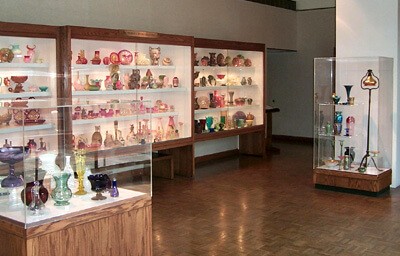
Morgan Vase on Stand, Hobbs, Brockunier and Co., Wheeling, West Virginia, United States, about 1887.

Decanter with stopper, Julius Proeger (American), Huntington Tumbler Co., Huntington, West Virginia, United States, about 1898-1905.
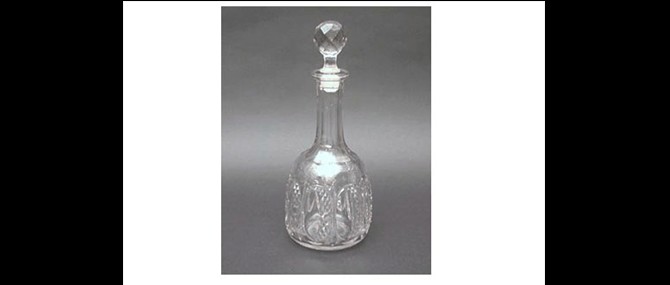
Vase, Mt. Washington Glass Company, Frederick Shirley, New Bedford, Massachusetts, United States, December 15, 1885 patent glass.
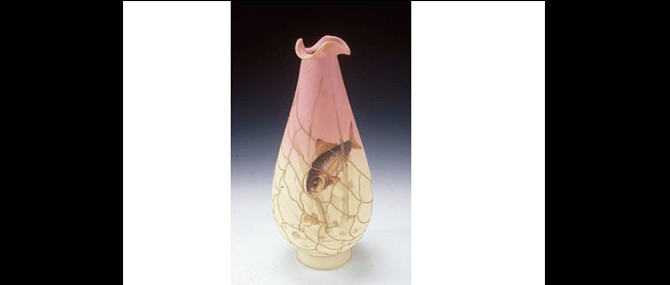
Vase, Guba, Mt. Washington Glass Company, New Bedford, Massachusetts, United States, 1890s.
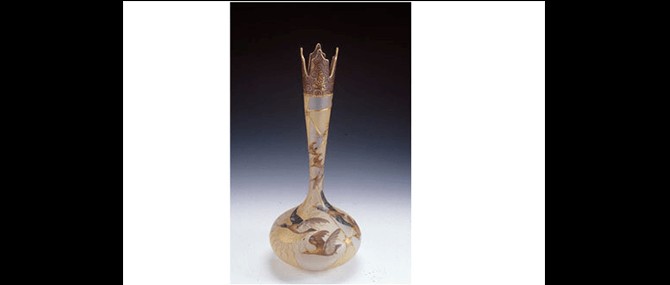
Vase, H.P. Sinclaire and Co., Steuben Glass Works, Corning, New York, United States, about 1919-1933.
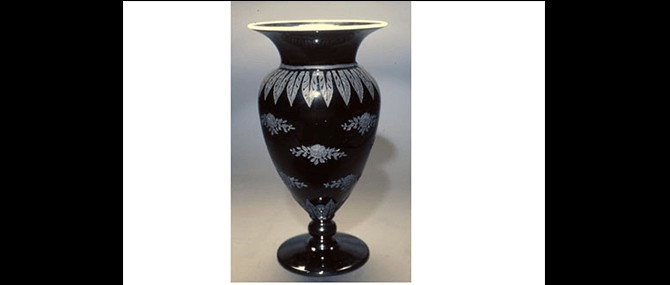
Milk Jug, Unidentified, Saratoga, New York, United States, about 1850.
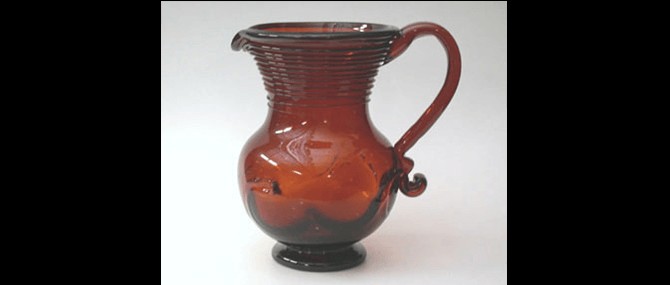
Mantel Vase, Unidentified, Pittsburgh, Pennsylvania, or Wheeling, West Virginia, United States, about 1850-1870.
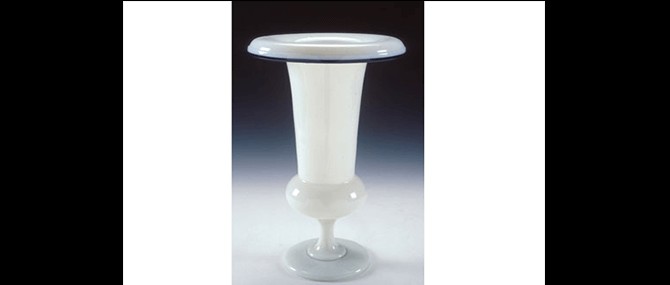
Morgan Vase on Stand, Hobbs, Brockunier and Co., Wheeling, West Virginia, United States, about 1886-1891.

Napoli Vase, Mt. Washington Glass Company, manufacturer and Albert Steffin, decorator, May 22, 1894
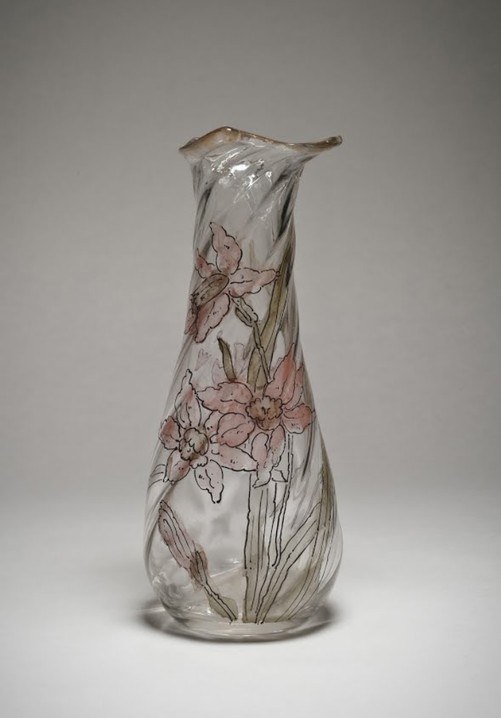
Backstory and Context
Text-to-speech Audio
Hundreds of glass factories once operated in West Virginia and the Ohio Valley. Although glass had long been produced in the state on a smaller scale, West Virginia did not emerge as an important glass manufacturing center until the end of the nineteenth century. This was due to the region’s abundant and inexpensive natural resources, especially natural gas and glass sand, along with the expansion of railroad networks and local campaigns to recruit manufacturing companies. At the same time, glassmaking became increasingly specialized, with separate factories manufacturing glass tableware, bottles and containers, and flat glass. During the 1890s, expanding markets and technological progress boosted all segments of the glass industry, allowing firms like Fostoria Glass Co., Fenton Art Glass Co., and Libbey-Owens-Ford Co. to build larger factories as the cost of production went down. By around 1910, West Virginia contained over four hundred glass factories that employed about 7,500 workers, making the industry the fourth-largest employer in the state. The glass industry flourished for decades before beginning to decline during the 1970s as aging domestic factories faced competition from newer manufacturers outside of the United States. Most West Virginia glass factories had closed their doors by the 1980s, leaving only a handful still in operation today, including firms like Blenko Glass, which now specialize in art glass rather than mass-produced glassware.
Despite the decline of the West Virginia glassmaking industry, a widespread interest in collecting glass developed in the region and led several museums to curate collections of glass items. The Huntington Museum of Art’s glass collection began in 1967 with the donation of the Daywood Collection, which included early examples of pressed “lacy” period glass made by the Boston Sandwich Company. The Museum went on to expand its holdings in early American, mid-Western/Ohio Valley, Art and Studio Glass during the 1970s. In 1976, the Museum was involved in a project titled “New American Glass: Focus West Virginia” which placed studio glass artists in six glass factories in West Virginia. The works created as a result of this project then became part of the Museum’s permanent collection. The Museum subsequently hosted annual invitational exhibitions for individual studio glass artists from 1978 through 1988. The Museum acquired many important works through these exhibitions, including pieces by studio glass pioneers such as Harvey Littleton, Dominick Labino, Fritz Dreisbach, Joel Philip Myers, Dale Chihuly, Michael Peisner, Toots Zynsky, Ginny Ruffner, and others.
With over four thousand objects, the Museum’s glass holdings now comprise its largest collection. The extensive collection of Ohio Valley glass, along with examples of American and European art glass, are displayed in an expansive visible storage format that allows approximately twenty-five percent of the collection to be on view at one time. The mid-Western/Ohio Valley glass collection follows the development of glassmaking throughout the region from the early eighteenth century to the present. The permanent glass gallery, designed as a study gallery, showcases a variety of types and techniques employed in glass manufacture, including mouth-blown, mold-formed pattern glass, pressed pattern and figural glass, as well as decorative techniques such as cut, etched and hand-painted glass. It features many examples of glass from the region’s heyday of glassmaking, as well as several cases of art glass donated by a local collector. Overall, the permanent collection presents a rich reference tool for collectors and researchers as well as a visual resource for those interested in the beauty of the medium.
Examples on display include glass manufactured by Atterbury, Bakewell, Pears & Co, Bryce Brothers, Gillinder & Sons, George Duncan & Sons, McKee and Brothers, Hobbs Brockunier, Central Glass, Riverside Glass, Northwood Glass, Fostoria Glass, Huntington Glass, and others. Several cases display American and European art glass donated by Wilbur E. Myers, a local collector. These cases contain glass made by Mt. Washington, Fenton, Libbey, Steven and Williams, New England, Thomas Webb & Sons, Schneider, Gallé, Daum, Louis Comfort Tiffany, Vineland Flint Glass Works, Steuben Glass Works, as well as glass from West Virginia factories such as Dunbar, New Martinsville, Viking, Paden City Glass, Huntington Tumbler, Old Morgantown, Akro Agate, The Pilgrim Glass Corporation, Rainbow Art Glass, Bischoff, and Blenko.
The Glass Gallery is currently undergoing a transition to a Decorative Arts Gallery, which will feature displays of glass, silver, and other objects from the Huntington Museum of Art’s permanent collection that visitors rarely get to see.
Sources
Fones-Wolf, Ken. Glass Industry, The West Virginia Encyclopedia. August 7th 2012. Accessed April 6th 2020. https://www.wvencyclopedia.org/articles/2116.
Glass Gallery, Huntington Museum of Art. Accessed April 6th 2020. https://www.hmoa.org/art/collections/glass.
Hart, Lorna. A Brief History of Glassmaking, Southeastern Antiquing and Collecting Magazine . July 1st 2012. Accessed April 6th 2020. http://www.go-star.com/antiquing/history-glassmaking.htm.
Nash, Betty Joyce. Economic History: West Virginia Glass Houses. Econ Focus (Federal Reserve Bank of Richmond), vol. 13, no. 145 - 48. Published Winter 2009.
https://www.hmoa.org/art/collections/glass
https://www.hmoa.org/art/collections/glass
https://www.hmoa.org/art/collections/glass
https://www.hmoa.org/art/collections/glass
https://www.hmoa.org/art/collections/glass
https://www.hmoa.org/art/collections/glass
https://www.hmoa.org/art/collections/glass
https://www.hmoa.org/art/collections/glass
https://www.hmoa.org/art/collections/glass
https://artsandculture.google.com/asset/napoli-vase-mt-washington-glass-company-manufacturer/qAHkguYlWmlNiQ
